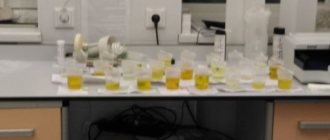What does it mean if you see blood in your saliva when you cough up?
In this case, the liquid enters the throat, flowing down the back wall of the nasopharynx.
The reasons for this phenomenon are hidden in the adenoids or damaged mucous membrane, for example, with pharyngitis. Usually the patient immediately coughs up the liquid that has entered the throat, but some of it may enter the oral cavity and, accordingly, mix with saliva.
Causes may also be hidden in the tonsils and back of the throat. Varicose veins are located in this part of the pharynx. Blood may be present in saliva with pharyngitis and other throat diseases; Capillaries can burst during a normal cough, when there is a lot of stress on the throat. This is often observed in diseases of the heart, kidneys, and liver; It is worth noting that such a symptom is one of the signs of heart failure. Many heart diseases, accompanied by weakening of its muscles, provoke stagnation of blood in the lungs. In turn, congestion does not occur without coughing, and the saliva becomes foamy and contains impurities; The cause may be bronchitis or pneumonia caused by a bacterial or viral infection. The disease is accompanied by a severe cough and the appearance of red blood. Other symptoms include general weakness, fever, chills, and pain when breathing. Both of these pathologies require the use of antibiotics; A similar phenomenon is observed with a benign lung polyp. People who smoke are primarily at risk. Any polyps in the respiratory tract can only be treated surgically. Pulmonary embolism manifests itself in a similar way - the formation of a blood clot in the respiratory organs. In this case, there is a lot of dark red blood in the saliva. The disease is accompanied by difficulty breathing, increased heart rate, and pain in the sternum when inhaling. It is worth noting that a characteristic symptom of embolism is swelling of one leg and increased sensitivity. Sometimes patients have a fever. After a few days, the blood turns from bright red to dark. Women taking hormonal contraceptive drugs are at risk; Pulmonary tuberculosis is accompanied by the fact that blood appears when coughing up. When a person sees such discharge, he first of all thinks about this disease. That is why an important preventive measure is fluorography of the lungs, which is carried out once a year; Cancer should not be ruled out. Typically, such ailments are accompanied by a constant, but not very strong cough.
Unfortunately, such diseases are treatable only in the early stages of development, so when the first alarming symptoms appear, you need to pay attention to them and consult a specialist.
Causes and symptoms of pulmonary edema during myocardial infarction
The symptoms of bleeding are usually not in doubt by its definition, but in such a condition additional signs of the disease may be observed. Thus, if bleeding is caused by a sick stomach, blood may appear along with vomiting. The latter will be caused by another spasm and attack of pain.
The following characteristic signs are identified that are observed in a patient during oral bleeding:
- Marked weakness.
- Dizziness.
- Panic.
- Trembling in limbs.
- Headache.
- Severe abdominal pain (if the bleeding is caused by diseases of the internal organs).
Categories
AllergistAnesthesiologist-resuscitatorVenereologistGastroenterologistHematologistGeneticGynecologistHomeopathDermatologistPediatric gynecologistPediatric neurologistPediatric urologistPediatric surgeonPediatric endocrinologistNutrologistImmunologistInfectious disease specialistCardiologistCosmetologistSpeech therapistElorologistMammologistMedical lawyerNarcologistNeurologistNeurosurgeon NephrologistNutriciologistOncologistOncourologistOrthopedist-traumatologistOphthalmologistPediatricianPlastic surgeonProctologistPsychiatristPsychologistPulmonologistRheumatologistRadiologistSexologist-AndrologistDentistTherapistUrologistPharmacistPhytotherapistPhlebologistSurgeonEndocrinologist
Causes of blood in saliva
Blood enters the mouth from various organs, such as the stomach, lungs, nose, liver or gums. If it appears in saliva, then this is an abnormal phenomenon, and it indicates the presence of some kind of disease. Sometimes people who do not properly care for their oral cavity may drool with blood. So, the common causes of bleeding in the mouth include the following.
Bleeding from the nose, not only during it, but also after it has stopped. After all, the remains of blood can be stored in the human body for up to a day; blood clots first fall into the throat and then into the saliva. And if the causes of nosebleeds are clear, then red saliva should scare a person.
Very often, hemoptysis occurs when teeth are not brushed properly, in which case it is noticeable when using a toothbrush. In this case, it is recommended to change the brush, and if blood continues to appear from the mouth, then you need to contact your dentist to prescribe treatment.
Bloody spots may indicate heart failure. After all, if the cardiovascular system is not in order, then blood stagnates in the lungs. In this case, you should immediately consult a doctor.
Vitamin C deficiency.
In the presence of blood clots in the saliva, inflammatory processes may occur in the lungs, in which the following symptoms appear: shortness of breath, fever, weakness, chills. In this case, immediate medical attention is needed.
Blood appears when polyps form, which most often form in people who smoke. If the tumor is benign, it can be cured through surgery.
If bloody streaks appear in the saliva, this may indicate cancer.
Blood appears due to the fact that a clot forms in the lungs, which is highlighted in a bright scarlet color. If the blood is released for several days, then every day it only becomes darker.
If blood appears in your saliva, you need to be examined by a doctor, as this may indicate tuberculosis.
If you have a taste of blood in your mouth, but there is no blood, then you need to pay attention to this and consult a doctor - this may be a symptom of a serious illness. If there is a small amount of blood in the mouth, you need to undergo an examination and take all the necessary tests
How to stop bleeding
What should you do if blood suddenly begins to come out of your mouth in large quantities, if independent treatment is impossible? First of all, you need to call an ambulance. In the meantime, she needs to take some measures to stop the bleeding.
If you secrete dark brown liquid and vomit with bloody lumps, this may indicate stomach problems. In this case, you need to swallow a small piece of ice and put something cold on the abdominal area.
- The presence of dark burgundy discharge that does not foam most likely indicates bleeding from the esophagus. While you are waiting for doctors, try not to move and raise your head slightly so that it is higher than the position of your legs.
- If blood is released with foam from a person’s mouth, the reasons for this may be damage to one or two lungs and bleeding from them. Refrain from talking and coughing, while also trying not to move and drink a couple of sips of cold water, and also swallow a piece of ice.
In any case, if bleeding from the mouth continues for several days, be sure to consult a specialist for advice and timely treatment.
Causes of saliva with blood
Every person understands that the saliva of a healthy person cannot contain blood. If it is, then there is a problem in the functioning of the body.
Blood in saliva can be detected when the mucous membranes of the throat are damaged, for example, with a strong cough. This may be a one-time occurrence, but if it appears constantly, then this indicates serious violations. In any case, it would be better to consult a doctor immediately to rule out pathologies and establish the correct diagnosis. Before visiting a doctor, a person should take cough medications: various decoctions and infusions.
Also, saliva with blood can be a signal of heart problems. With many diseases of the heart and blood vessels, which weaken the heart muscle, blood stagnation forms in the human lungs. In this regard, a cough, foamy saliva and streaks of blood may appear. It is impossible to make a diagnosis and prescribe treatment on your own. You should immediately contact a cardiologist when the first symptoms appear. Treatment for heart failure can only be prescribed by a specialist in this field and only after a thorough examination and tests.
The development of bronchitis and pneumonia can also contribute to the appearance of blood in saliva. You can understand that this was the cause by the following symptoms: fever, chest pain, general weakness, chills
It is important to understand that lung diseases are treated with antibiotics. Self-medication in this case is strictly prohibited; it is important to strictly follow all the recommendations of the treating doctor.
Another cause of this disorder is a lung tumor. People who smoke are at risk of developing many diseases, including cancer. As is known, not all neoplasms are malignant. If the lung tumor is benign, then there is a chance to completely cure it.
Also, saliva with blood can appear as a result of a disease such as pulmonary embolism - blood clots entering the lungs. The main symptom of the disease is copious amounts of deep red blood in the saliva. Symptoms also include shortness of breath, rapid pulse, and chest pain. Typically, with a pulmonary embolism, one leg swells and the temperature rises. Within a few days the blood turns dark red. The risk group usually includes smokers, women taking contraceptives, and those suffering from thrombophlebitis of the lower extremities.
This problem may also occur due to pulmonary tuberculosis. This is precisely the assumption that arises in almost all people who notice blood in the mouth
In this case, you should once again be reminded of how important it is to carry out fluorography on time. Unfortunately, statistics show that the incidence of tuberculosis is growing every day
Therefore, at the first appearance of even a small amount of blood in saliva, you should immediately do fluorography and rule out this dangerous disease. If tuberculosis is still detected, there is no need to despair. If you follow all the doctor's recommendations, tuberculosis can be cured.
The most dangerous reason for the appearance of blood is an oncological problem. With lung cancer, a mild cough may occur. Any cancer can be treated only if it is diagnosed on time. Typically, cancer diagnosed in the later stages is difficult to cure and therapy often does not bring positive results.
Therefore, it is very important to carry out timely diagnosis, take tests and undergo medical examination.
It is worth noting that the presence of a taste of blood without its presence may also indicate a serious illness. This can be a disease of the heart and blood vessels, gastrointestinal tract and many other organs.
Any alarming symptoms are a reason to contact a medical institution for qualified help. You should not let the disease take its course, as timely detection of pathology will help avoid many health problems.
Prevention
To reduce the likelihood of bleeding, you must first undergo routine medical examinations to identify diseases of the gastrointestinal tract and pulmonary system. If ulcers are detected, it is necessary to undergo courses of antisecretory and anti-Helicobacter therapy. When taking anticoagulants, do not exceed the dosage and duration of use indicated by your doctor. During treatment, take control tests to determine the parameters of the coagulation system.
For pulmonary tuberculosis, liver cirrhosis, hepatitis, undergo appropriate therapy. Also lead a healthy lifestyle - avoid smoking and alcohol. In order not to provoke bleeding of blood vessels due to vitamin deficiency, eat a balanced diet, and take multivitamin preparations to prevent hypovitaminosis.
Any internal bleeding is potentially dangerous as it can reoccur, especially if no treatment is taken. Blood from the mouth associated with diseases of the oral cavity and bleeding gums does not pose a mortal danger to humans. Even if the bleeding from the mouth stops on its own, you need to go to the doctor.
When you spit out blood
But there are a number of more serious diseases that require additional examination and more serious treatment, and spitting blood is just a small bell indicating that you should take your health more seriously.
Among the serious reasons why you may have blood in your saliva, an important place is occupied not by a specific disease, but by a whole complex of symptoms. To diagnose a specific disease, you will have to see a doctor. The causes of these diseases may be hypothermia, decreased immunity, they may be of viral bacterial etiology
The causes of these diseases may be hypothermia, decreased immunity, or they may be of viral bacterial etiology.
Predisposing factors include smoking. Very often, heavy smokers suffer from chronic bronchitis, which can last for years.
With one and the second disease, a severe cough is noted, the amount of sputum produced depends on what kind of process it is. So, with chronic bronchitis not associated with smoking, most often there is a dry cough, shortness of breath, pain in the chest and abdominal walls, from a long debilitating cough.
Some researchers claim that the percentage of patients has decreased significantly in recent years, while other statistics indicate that every minute, one person with tuberculosis dies around the world.
It has been scientifically established that every person has a tuberculosis bacillus in their body, but for the time being it remains in a latent state, but under the influence of various unfavorable factors it can turn to aggression and cause tuberculosis.
Treatment of tuberculosis is very long and requires constant monitoring and observation. To fully recover, you need to radically change your lifestyle and diet.
Much attention should be paid to rest, during the recovery period, work should be included gradually, avoiding nervous breakdowns
In terms of treatment, kumys and tarbaganye lard have an excellent healing effect. The following medications are used: streptomycin, ftivazid, para-aminosalicylic acid, the course of treatment with these drugs is 4 months.
A branch of the bronchus that has such pockets does not perform its cleansing function well, since the villi of the bronchial epithelium, whose main mission is to promote sputum to the exit, do not cope well with this, and a large amount of sputum is collected, which stagnates in the bronchial cavity, which provides an excellent environment development of microorganisms.
There is no complete cure for this pathology, since the changed bronchi are no longer able to recover to their previous state. Only symptomatic treatment is possible.
In the treatment of this disease, anticoagulants are used to reduce blood clotting and drugs that help dissolve existing blood clots. It should also be taken into account that embolism can occur even if you do not have thrombophlebitis.
https://www.youtube.com/watch?v=44qPPzJWVDw
It's worse if the biopsy results confirm that you have lung cancer. But even in this case, this is not a death sentence; modern medicine can cope with this scourge.
Diagnosis of causes
To determine why a person is bleeding, you need to contact a specialist and undergo the necessary procedures. To identify the cause of hemoptysis, the following procedures are performed: you need to take a blood test, give Mantoux, take a general sputum test, and do a CT scan. You need to undergo bronchoscopy, collect sputum for microflora, and do fluorography. Get a biopsy, a blood clotting test, an MRI and an ECG.
https://youtube.com/watch?v=bjxkNsPKTxE
First you need to visit your local therapist. After the initial examination, if the doctor identifies alarming symptoms, he will give a referral for examination to specialists.
Pulmonary diseases
The list of serious pathologies indicated by an unusual symptom is wide. In rare cases, it becomes a distant indication of cancer, hemophilia (blood clotting disorder), autoimmune diseases such as lupus, rheumatoid vasculitis, or helminth infection.
Blood in saliva without coughing may indicate the development of hemophilia
You can suspect the disease on your own if the temperature is constantly elevated - about 37.2 degrees, weakness, chills are observed, and the person sweats heavily during sleep.
Also, blood streaks in saliva appear during the following conditions:
- Pneumonia. If, when coughing, red streaks are visible, possible clots of greenish or yellow mucus, and this is accompanied by weakness, fever, shortness of breath, consult a physician. Sometimes these symptoms indicate a bacterial infection that affects the lungs. Similar symptoms are characteristic of bronchitis.
Thromboembolism is accompanied by the appearance of blood in saliva
- Pulmonary embolism. Accompanied by foamy red streaks in the saliva, it remains light in color.
- Lung abscess. It develops as a consequence of advanced purulent pneumonia; the sputum with it has an unpleasant odor and is viscous.
- Sinusitis, sinusitis. Diseases affect the nasal sinuses, from where secretions can flow down the back wall of the pharynx and enter the oral cavity (especially in the morning, after sleep). A symptom with bloody discharge indicates the development of an inflammatory process, weakness of damaged blood vessels, and therefore requires drug treatment.
Aortic aneurysm causes bleeding in saliva
A small volume is considered to be 100–300 ml per day, medium – from 300 to 500 ml, heavy – more than 500 ml. However, such a gradation is conditional. If 50 ml or more is periodically detected in the spit, it is necessary to carry out a series of diagnostic procedures that will indicate a specific health problem.
Often prescribed:
Study of pulmonary pathology. To do this, they resort to radiography (today this is the most informative method), ultrasound, and computed tomography.
Bronchoscopy is performed to diagnose the patient's condition.
- Bronchoscopy. Examination of the lumens of the bronchial tree is recommended in case of suspected inflammation or malignancy. However, there are also less traumatic methods.
- Cardiography, which helps to exclude cardiac pathologies.
- Study of biological materials (sweat, saliva, sputum, blood) for the presence of tuberculosis infection, respiratory cystic fibrosis.
Additional symptoms can help the doctor make initial conclusions: body temperature, the presence of recent illnesses, chills, periodic coughing. Based on these data in conjunction with the results of more informative research methods, the doctor prescribes therapy.
A saliva test will help clarify the diagnosis.
There are several types of it, depending on the volume of excretion per day:
- true hemoptysis (up to 50 ml);
- light bleeding (up to 100 ml);
- medium intensity (up to 500 ml);
- copious amounts (up to 1 liter per day).
The symptoms that accompany this pathology (warmth in the lung area, fever, severe cough with a salty taste of discharge) are usually not paid attention to.
But they are the harbingers of a pathogenic internal process. It is better to go to the hospital immediately than to remain in the dark and do nothing.
- Mitral stenosis. Narrowing of the mitral valve can lead not only to disturbances in circulatory function, but also in breathing. The resulting pulmonary edema can lead to bleeding.
- Pulmonary embolism. If the pulmonary trunk is blocked, it is quite possible that bloody discharge will appear a few days after the incident.
- Aortic aneurysm. The expansion of the aorta reduces its ability to pump pressure, which also leads to congestion in the lungs and can cause the appearance of blood in the saliva.
Among them, a special place is occupied by systemic connective tissue diseases, which often have diverse and variable symptoms:
- Lupus;
- Goodpasture's syndrome;
- Sarcoidosis;
- Polyarteritis nodosa;
- Wegener's granulomatosis.
The list of “other” ailments will include pathologies associated with hematopoiesis and blood coagulation ability: thrombocytopenia, hemophilia, hemorrhagic diathesis.
A special place among others is occupied by vitamin C deficiency - scurvy. With this disease, due to the impossibility of correct collagen synthesis, periodontitis develops, manifested by bleeding gums.
First aid
If you are bleeding from the nose, you should not tilt your head back and swallow the blood (it should flow out) - this can cause vomiting. You should not blow your nose, as this may increase bleeding. The head is tilted forward and the blood is spat out. The wings of the nose are pressed on both sides for 5-10 minutes in order to compress the vessels. Cold is placed on the bridge of the nose (ice, a bottle of cold water, any other cold object). For moderate discharge, vasoconstrictor drops (for example, Naphthyzin) can be instilled. If the blood continues to flow, you need to insert cotton swabs soaked in hydrogen peroxide into the nasal passages, and your head should also be tilted down. If there is no effect, go to the hospital.
If blood comes from the mouth due to internal bleeding, you should call an ambulance. If you suspect gastrointestinal blood loss, you need to lie on your back, place a pillow under your legs to raise them by 15-20°, and apply cold to the upper abdomen. You cannot get out of bed or eat until the ambulance arrives. Since when moving or eating food, bleeding may increase, but a person cannot independently determine whether it continues or not.
To cause vasospasm, reduce blood loss, you can drink ice water in small sips or swallow pieces of ice. If vomiting recurs, turn your head to the side, but do not stand up. In case of pulmonary hemorrhage, on the contrary, you cannot lie down, only sit or half-sitting, cold on the lung area. In order not to cause hypothermia, the cold is removed every 15 minutes for 5 minutes. It is necessary to lean towards the lung from which the blood is supposedly flowing so that it does not enter a healthy organ. Tourniquets may be applied to the legs to reduce the amount of fluid that flows into the lungs.
It is difficult to determine the affected side on your own, but you can navigate by the symptoms, that is, on which side you hear wheezing, gurgling, whistling or pain. You can’t drink or eat, you can only swallow ice cubes and drink sips of ice water. You cannot take any medications on your own for internal bleeding, as they can erase the clinical picture or increase blood loss; the necessary medications will be administered by emergency doctors.
Coughing up blood: possible causes
A person usually begins to panic when he coughs up blood. The reasons for this can be very different, including diseases of the pulmonary system. The main thing is to figure everything out by consulting a doctor in a timely manner.
Of course, hemoptysis (coughing up saliva or sputum mixed with blood) is a cause for concern. Remember that the color of the blood itself can help diagnose the cause. Thus, a cough with bright red blood or sputum with foam indicates respiratory diseases, while a dark color indicates problems in the gastrointestinal tract.
So, coughing up blood can indicate a variety of lung diseases, internal bleeding. Sometimes, when the blood in the sputum when coughing is not pronounced, only some streaks are observed, it is possible that this is caused by a rupture of a small blood vessel in the lung area. This condition is not dangerous to health. However, another reason for this may be an inflammatory process in the lungs (pneumonia, tuberculosis, tumor), which causes much more serious concerns.
One of the main criteria by which you can determine how dangerous a cough with blood is in your case is its systematic nature and analysis of your general condition. If you cough occasionally and feel fine, there is no reason to worry. If blood appears constantly, a visit to the doctor is inevitable.
Remember that if you have chronic bronchitis, it is unlikely to cause blood in your sputum. As a rule, this type of bronchitis does not have similar symptoms. But consultation with a doctor is necessary; any causes of this condition are possible.
If blood appears in saliva, this is a cause for serious concern, because it indicates the presence of serious diseases (pneumonia, acute bronchitis, lung cancer).
In order to usually determine the factors that caused the appearance of coughing with blood, you need to make sure where the blood comes from: from the intestines, stomach or lungs. You need to be able to distinguish between vomiting blood and coughing:
- Immediately before coughing, the patient feels some tingling in the throat, and the blood foams and has a bright red color.
- If you are worried about vomiting blood, then it should have been preceded by nausea and discomfort in the abdomen. The blood itself is similar in appearance to thick paint.
There are some main factors that cause blood in sputum:
- the presence of inflammatory processes in the lungs (bronchitis, pneumonia, tuberculosis, lung abscess);
- tumors of varying degrees and locations;
- other diseases of the pulmonary system.
Regarding the treatment of coughing with blood, it should be noted that it entirely depends on the cause of its occurrence. If it appears as a result of the development of lung cancer, then the main treatment is chemotherapy, radiation therapy or surgery. If the use of these methods is successful, the cough with blood disappears.
When the root cause of the disease is tuberculosis, there is a need for anti-tuberculosis therapy (the use of anti-tuberculosis drugs and immunomodulators). Immune modulators are medications that strengthen the immune system and carry out humoral regulation.
In the presence of acute bronchitis, treatment is carried out using antibiotics. When a doctor diagnoses a lung abscess, surgical intervention is usually required.
In any case, whatever the causes of blood in the sputum, it is necessary to consult a doctor to clarify them and prescribe adequate treatment. Take care of your health and never be afraid to seek help from specialists!
fb.ru
"Ketanov"
A popular pain reliever for toothache. Its effect is comparable to morphine and exceeds the effect of most analgesics by 350 times. However, the medication is not addictive and does not affect opioid receptors.
Before visiting the doctor, you can take a pain reliever.
It is necessary to take 10 ml on an empty stomach. The maximum daily dose is 40 ml. The course is no more than 5 days. Do not take with other non-steroidal anti-inflammatory drugs (NSAIDs), as ulcers and gastrointestinal bleeding are possible.
"Ketanov" is prohibited when:
- diseases of the respiratory system: asthma, bronchospasm;
- stomach ulcer;
- renal and liver failure;
- stroke;
- teenagers under 16 years of age;
- pregnant and lactating women.
The main active ingredient is ketorolac.
Analogs - “Ketolak”, “Ketorol”, “Ketorolac”, “Aertal”. All medications perfectly relieve acute pain, even with pulpitis, inflammation in the dental canal and at the root apex, and infectious diseases of the jaw apparatus.










